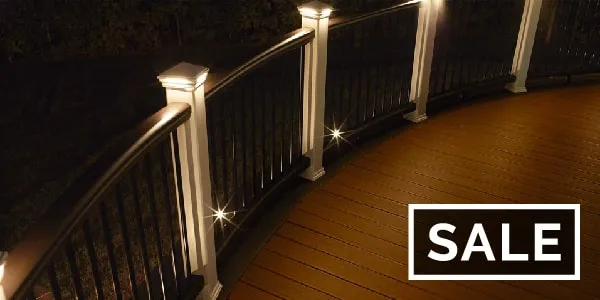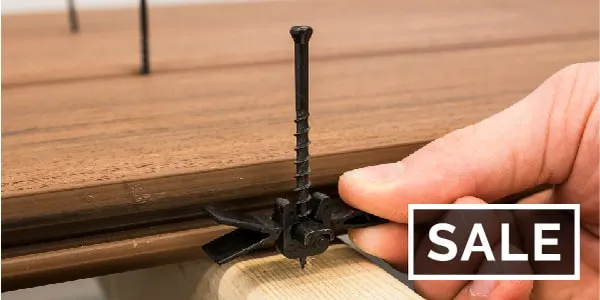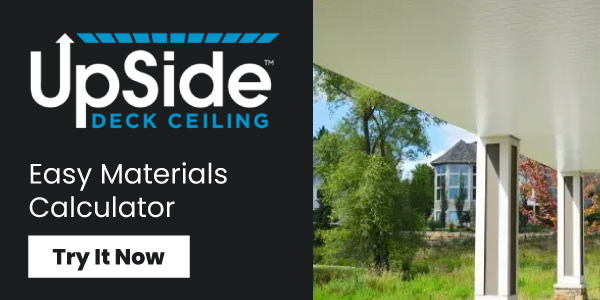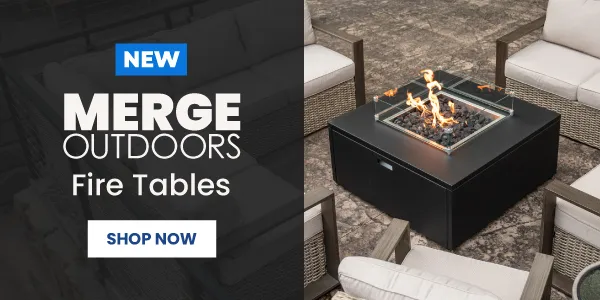How To Choose Energy-Efficient Deck Lighting
Table of Contents
I. Modernization of Light Bulbs
II. Choosing the Right Deck Lighting
III.How to Save Energy on Deck Lighting
IV. How to Maintain Deck Lighting Systems
V. References
Introduction
Deck lights enhance the beauty, safety, and security of outdoor spaces. Hence, it’s no surprise why they are widely used around the country, but interestingly, the lights that people enjoy today have not always been that way.
In 1879, Edison and his team’s first incandescent light bulb could only last for 14.5 hours. Today, LED light bulbs can last up to 50,000 hours. Older lamps were also inefficient and wasted a lot of energy.
Light bulbs have come a long way. Consumers now have endless options for lighting solutions. Of course, each has its own advantages and disadvantages, but one of the most important features of a lighting product is its energy efficiency.
Good lighting is essential if you want to spruce up your outdoor space. However, lights need energy, and energy costs money. If you want to save on energy costs, you need to use energy-efficient lights for your deck. This guide will help you choose the best lighting products for your outdoor space.
Modernization of Light Bulbs
Contrary to popular belief, the invention of the light bulb is not credited to one inventor. The light bulbs that are known and widely used today took decades to develop and are the results of the works of many researchers and inventors.
Here’s a timeline of how the light bulb was developed, taken from “The History of the Light Bulb,” an article published on the website of the US Department of Energy.
Timeline of the Invention of the Light Bulb
1803–1809: Cornish chemist and invention Humphry Davy invented the Davy lamp, an early form of an arc lamp. Davey presented his lamp to the Royal Institute in Great Britain. The arc lamp lights up streets in many cities.
1835: Scottish inventor and author James Bowman Lindsay presented and demonstrated the first constant electric light at a public meeting in Dundee, Scotland.
1850: German glassblower Heinrich Geissler and physician Julius Plücker invented the Geissler tube, which became the model for many lighting technologies, like fluorescent lights, low-pressure sodium lamps, and neon lights. The Geissler tube could produce light when all the air was removed inside a long glass tube and electrical current was passed through it.
1877–1885: Many inventors from all over the world were working to develop the first electric incandescent light. William Sawyer and Albon Man, from the US, and Joseph Swan, from England, made their own versions of incandescent bulbs. In October 1879, Thomas Edison and his researchers at Menlo Park created a light bulb with carbon filament that could last for 14.5 hours.
William Sawyer and Albon Man established the Electro-Dynamic Light Company to produce incandescent lamps. They held the patent for incandescent lamps from 1879 through 1885, successfully defending it against Edison’s company. Edison’s company merged with Thomson-Houston Electric Company, which was producing the incandescent bulbs under the Sawyer-Man patent, and formed General Electric (GE).
Edison focused on developing a whole lighting system. In 1882, he demonstrated how electricity could be distributed from a centrally located generator using the Holborn Viaduct in London.
1901: Peter Cooper Hewitt marketed his first mercury-vapor lamp, which was one of the precursors to fluorescent lights.
1904: European inventors used tungsten filaments in incandescent lamps. These bulbs appeared in the European market that year. They were brighter, more long-lasting, and more efficient than lamps with carbon filaments.
1908: The Edison Screw became the most commonly used light bulb socket. Today, the Edison Screw is a standard light bulb socket for electric light bulbs and is used in almost all residential applications.
1913: American chemist, physicist, and engineer Irving Langmuir doubled the efficiency of incandescent lamps by filling the light bulb with inert gas like nitrogen as opposed to removing all air from inside the bulb.
1926–1934: From the late 1920s to the early 1930s, European researchers experimented with phosphorus-coated neon tubes. These experiments ignited research on fluorescent lamps in the United States. American lighting companies demonstrated their fluorescent lights to the US Navy by the mid-1930s and late 1930s.
1939: GE and Westinghouse demonstrated their fluorescent lamps at the New York World’s Fair and the Golden Gate Exposition in San Francisco.
1951: The need for efficient lighting during World War II ushered in more demand for linear fluorescent lamps than incandescents. Soon, fluorescents overtook incandescents.
1962: Nick Holonyak Jr. created the first visible-spectrum LED (light emitting diode) in the form of red diodes during his time in General Electric. Pale yellow and green diodes followed soon after.
1973: An oil crisis prompted engineers to develop a fluorescent bulb used for residential applications.
1974: Researchers at Sylvania experimented with making more compact fluorescent lamps by significantly reducing the size of the ballast and tucking it into the lamp. They patented their light bulb but could not find a way to mass-produce it.
1976: While working at General Electric, Edward Hammer found a way to bend the fluorescent tube into a spiral shape. This led to creation of the first compact fluorescent light (CFL).
1978: After its creation, researchers continued to improve on red diodes and their production. Soon, incorporated LEDs would appear in consumer products, like calculator displays and indicator lights.
1985: CFLs became available in the market. A bulb cost between $25 and $35. The high price kept most consumers from buying them. The early CFLs were also big and bulky, would not fit well into fixtures, and did not have a stable performance.
1994: Blue diodes were invented and led to the creation of white LEDs. Soon after, researchers showed how to produce white light using red, green, and blue LEDs.
2000: The US Department of Energy worked with American lighting companies to create high-efficiency packaged LED devices to bring the technology to the forefront of the industry.
2002–2008: LED lamps become available to consumers. There are only a few on the market with 25- to 40-watt equivalents.
2008: The Energy Department announced the L Prize Competition to prompt the development of highly efficient solid-state lighting products that would replace the less-efficient common lighting technologies.
2011: Philipps’s entry won the L Prize competition in the 60-watt (W) replacement category.
2012: Over 49 million LED products were installed in the United States that year. The annual energy savings reached $675 million.
2013: Almost 30 years since it was first developed, CFLs now use about 75 percent less energy and last 10 times longer than incandescent bulbs do. One CFL bulb now costs as low as $1.74. LED lights are also getting significantly more affordable, with prices falling more than 85 percent.
2020: Ultraefficient LED lights are everywhere, from public places and commercial establishments to residential homes, vehicles, television sets, and smart devices.
Choosing the Right Deck Lighting
Deck lighting can accentuate your backyard features and provide safety and security to your family and home. It illuminates your outdoor space, making it more comfortable and convenient for everyone. More than 20 years ago, lighting fixtures were big, bulky, and inflexible. Nowadays, lighting products can be very compact and come in a variety of styles and designs.
When choosing the right deck light, one should consider the type of lighting and the lighting style that will harmonize with the overall design of your outdoor space. Decks Direct lists these types of lighting and different light designs and styles in its lighting guide on how to choose deck lighting.
Two Common Types of Deck Lighting
Low-Voltage Lighting
Low-voltage deck lighting is a reliable and consistent lighting solution for outdoor spaces. It uses a transformer to convert standard 110-volt energy to 12-volt current level. Low-voltage lighting can be used with dimmers and timers, allowing more customization for outdoor spaces. Installing this type of lighting requires wiring. Low-voltage lighting is recommended for new deck construction or when replacing railing to hide the wires and connectors more thoroughly.
If you want to install low-voltage lighting to your current deck, check out this guide on how to hide electrical or lighting wires outside.
Advantages of Low-Voltage Lighting
- Most consistent lighting power type
- Compatible with dimmers and timers
- Reliable for every yard and region
- Tons of lighting options available on the market
Solar Lighting
Solar deck lighting harnesses the sun’s power to provide energy to lighting fixtures. Solar fixtures are usually connected to a solar collecting post to run. This type of lighting needs little to no wiring, making it quick and easy to install.
Solar lighting is ideal for yards and regions that experience an abundant amount of direct sunliht as solar panels harness sunlight and convert it to energy for the batteries that run the lights. Solar lights typically run through a photocell that automatically turns the light on when the ambient sunlight is low.
Advantages of Solar Lighting
- Little to no wiring necessary
- Environmentally friendly
- More energy savings
- Turns on automatically when it gets dark
- Excellent lighting option for hard-to-reach spaces
- Perfect lighting solution for existing decks
Low-Voltage Lighting or Solar Lighting?
Solar lighting is great for saving money on energy and installation. It needs little to no wiring and can be installed on existing decks without hassle. Solar lights don’t run stably without abundant direct sunlight. Solar-powered lights may not turn on or may have lower light output on days with little sunlight. Typically, solar lights are only available for post caps and side mounts.
Low-voltage lighting is a better alternative for homeowners looking for a consistent and reliable outdoor lighting solution. However, they need to be prepared to install a power source, wiring, and connectors, which can take some work, depending on the size of the outdoor space.
Different Light Designs and Styles
Different light designs and styles are used to accentuate and illuminate entire outdoor spaces, from the railings to the yard. These are the outdoor lighting fixtures that you will find in many yards and decks.
| Outdoor Lighting Fixtures | Description |
| Post Cap Lights | These are lighting fixtures that go on top of rail posts. They seal the top of posts to prevent water from getting in and damaging the wood. Post cap lights illuminate decks, balconies, and similar structures. They also come in different styles—modern, vintage, minimalist, elaborate. |
| Side Mount Lights |
As the name suggests, these lights are mounted on rails or walls to provide a gentle glow down your posts. It’s perfect for a deck to add subtle lighting and to accentuate certain areas of your deck. |
| Under Rail Lights |
Installed under rails, these lighting fixtures brighten cramped spaces, outdoor cooking areas, and hard-to-reach sections. Under rail lights are discreet, but they can significantly enhance the aesthetic of any deck space. |
| Stair and Step Lights |
Stair and step lights increase the safety of outdoor spaces, especially multilevel decks, by making it easier to see those steps on the stairs when it gets dark. |
| Landscape Lights |
Landscape lights highlight the yard features and brighten walkways. There is a wide range of landscape lights to accentuate your outdoor space, from path lights to wall wash. |
The different outdoor lighting fixtures each serve their own functions and enhance different features of your outdoor space. When combined, they add immense beauty, safety, and security to your space.
How to Save Energy on Deck Lighting
A well-lit outdoor space uses a variety of lighting fixtures to brighten the entire area and to highlight certain features of the deck. All these lights use energy to run. The cost of running an outdoor lighting system varies, depending on the type of lights, the number of light bulbs, how long you run the lights, and the cost of electricity in your area.
If you have an outdoor lighting system, here are a few ways to save energy on your deck lighting:
- Check the product label. Light bulbs should have product labels that specify the lumens, watts, life span, voltage, and light appearance of the product.
- Shop lumens, not watts. Lumen measures how much visible light is emitted by the light bulb. Watt is a unit of measurement for how much energy is used. The higher the lumens, the brighter the light source. The lighter the watts, the more energy the lamp uses.
To save on energy and to get enough brightness for your outdoor space, follow these tips from the Energy Department:
- Replace a 100W incandescent light bulb with an energy-efficient bulb with about 1,600 lumens.
- For a 75W bulb, choose an energy-efficient light bulb with about 1,100 lumens.
- For a 60W bulb, choose an energy-efficient light bulb with about 800 lumens.
- For a 40W bulb, choose an energy-efficient light bulb with about 450 lumens.
- Choose energy-efficient lights. There are three most popular light bulb options widely available in the market today: halogen incandescents, CFLs, and LEDs. They can be more expensive than incandescents are, but the energy savings more than makes up for the higher initial cost.
CFLs and LEDs give the most energy savings and are the ideal choice for outdoor spaces, where lights are left running for a long time. Between CFLs and LEDs, the former uses about 25 percent energy and lasts ten times longer than an equivalent traditional incandescent light bulb does.
On the other hand, LEDs use only about 20 to 25 percent of the energy and last 15 to 25 times longer than comparable traditional incandescent lights do. Compared to halogen incandescent, LEDs use 25 to 30 percent of the energy and last 8 to 25 times longer.
When it comes to energy efficiency, light-emitting diodes (LEDs) reign supreme. Today, a vast majority of deck lighting options use LED technology for its many advantages. If you’re shopping for LED lights, check out this guide to choose the ideal LED lights for your deck.
- Try solar lights. If you live in an area that gets plenty of sunlight, use solar-powered lights for your outdoor space. The solar panel harnesses energy from the sun, which is free, and converts it to electricity to power the solar lighting fixtures.
- Use a photocell or motion sensor. A photocell detects light and turns on the lighting fixture when the surrounding light is low while a motion sensor activates the light source when it detects movement. Using a photocell or motion sensor can increase energy savings since it automatically shuts down the lights when there’s ample sunlight (for photocells) or when it doesn’t sense motion (for motion sensors).
- Install a timer. It’s easy to forget to shut down outdoor lights. A timer can automatically turn on your outdoor lighting system during the times you need it and turn it off when you don’t. A timer brings more savings and convenience into your life and adds security to your home.
- Keep lighting fixtures clean. Dirt on light bulbs absorbs light and reduces their efficiency and life span. Keeping them clean will help them stay bright and last longer.
LED technology has opened up a world of brightness for outdoor spaces (and any space, for that matter). Keeping outdoor spaces well-lit is now possible and affordable for every consumer because of energy-efficient lighting solutions.
How to Maintain Deck Lighting Systems
Outdoor lighting fixtures are constantly exposed to the elements, so they get dirty faster and get damaged more frequently than indoor lights do. Proper care and maintenance help your deck lighting systems last longer and work more efficiently until the end of their life spans.
Here are some tips for maintaining your outdoor lighting systems:
- Clean lighting fixtures regularly. Keeping your lighting fixtures clean helps them work efficiently and last until the end of their life spans. Dirt, dust, insects, moisture, and mold can damage and break your lighting system, so it’s vital to clean them regularly.
Check out these helpful tips for cleaning outdoor lights to get the best results without damaging the fixtures and deck.
- Observe proper cleaning practices for solar lights. You don’t need special products or tools to clean solar lights, but take special care when cleaning the solar panels and batteries to avoid problems. This guide will walk you through the proper steps to clean solar deck lighting.
- Schedule maintenance checks on your lighting system. Since there’s a higher likelihood for damage, check your outdoor lighting system more frequently, especially after rainy days and extreme weather conditions. Doing so may save you from electrical accidents and fire. Look for exposed wires and cables, and check for any damage that needs fixing before reburying them.
- Replace dead light bulbs immediately. Empty sockets are safety and fire hazards. If you can’t replace a dead light bulb right away, keep it in the socket for your safety.
Observe proper disposal and recycling of dead light bulbs. Fluorescent lights, including CFLs, contain mercury, which can be released into the air when a light bulb breaks. Dispose light bulbs with mercury at a local hazardous waste center.
- Trim plants and branches. Plant-life around your lighting fixtures may cause them damage or block the light. To avoid that, cut back any plants that are on the fixtures.
Regular and proper care and maintenance keep your deck lighting system working smoothly for a long, long time. With good lighting, your deck can continue to be safe, secure, and gorgeous.
References
DecksDirect. (n.d.). Lighting Guide—Decks 101: How to Choose Deck Lighting. https://www.decksdirect.com/how-to-choose-deck-lighting
DecksDirect. (2020). Decks Direct: Recycling and Disposal Guide for Deck Lights. https://www.decksdirect.com/deck-lights-disposal-recycling
Matulka, R., & Wood, D. (2013, November 22). The History of the Light Bulb. Energy.Gov. https://www.energy.gov/articles/history-light-bulb
US Department of Energy. (n.d.-a). Lighting Choices to Save You Money. Energy.Gov. https://www.energy.gov/energysaver/save-electricity-and-fuel/lighting-choices-save-you-money
US Department of Energy. (n.d.-b). Lumens and the Lighting Facts Label. Energy.Gov. https://www.energy.gov/energysaver/save-electricity-and-fuel/lighting-choices-save-you-money/lumens-and-lighting-facts






